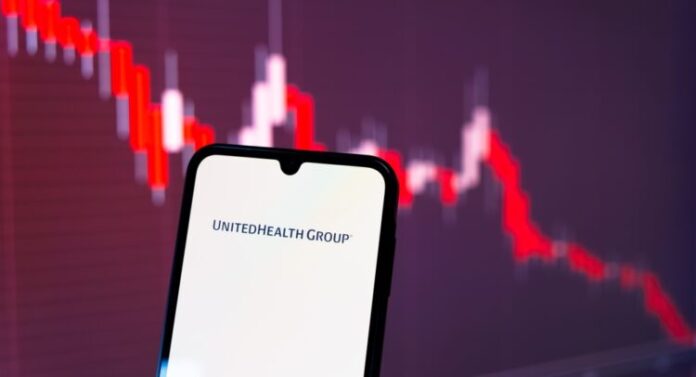New York, April 17, 2025 — Wall Street woke up to a jolt this morning as shares of UnitedHealth Group Inc. (NYSE: UNH) took a sharp dive, falling more than 20% in premarket trading. For a blue-chip stock in a defensive sector like healthcare, that kind of drop is unusual — and it has investors asking some serious questions. Discover the 2025 outlook for UnitedHealth Group (unh stock) including key growth drivers, risks, and analyst forecasts in a changing healthcare and political landscape
The catalyst? A disappointing first-quarter earnings report coupled with a lowered profit forecast for the full year. And while the numbers themselves might not seem catastrophic at first glance, it’s what’s underneath them — and what they imply about the future — that has the market rattled.
A Closer Look at the Numbers
UnitedHealth reported adjusted earnings per share (EPS) of $7.20 on revenue of $109.58 billion. Wall Street had been expecting EPS of around $7.29 and revenue closer to $111.5 billion, so on paper, it’s a modest miss. But context matters.
What really spooked investors was the downward revision in the full-year outlook. The company now expects EPS between $26.00 and $26.50, down significantly from its earlier range of $29.50 to $30.00. That’s not just a slight tweak — it’s a major realignment.
In the world of big insurers, a forecast cut of that magnitude isn’t just a bump in the road. It’s a flashing red light.
The Culprit: Higher-than-Expected Healthcare Utilization
So what happened?
In plain terms: more people are using their healthcare benefits — particularly seniors enrolled in Medicare Advantage plans, a major segment of UnitedHealth’s business. And they’re not just going for routine checkups. There’s been a notable increase in elective procedures and hospital visits.
Executives pointed to a “rebound in non-urgent care utilization” after several quarters of subdued activity, possibly linked to pent-up demand post-COVID and demographic shifts. But whatever the reason, it means UnitedHealth is paying out more in claims than they expected.
The medical care ratio (MCR) — a key metric that shows the percentage of premiums spent on claims — jumped to 85.3%, up from 82.2% a year ago. That’s a big move, and it eats directly into profit margins.
Investors React — And Not Just in unh stock
The reaction from investors was swift and brutal. Shares of UNH fell by over 20% in premarket hours, and the shockwave hit other major players in the managed care space.
Humana, another Medicare Advantage giant, saw its stock fall around 10%. CVS Health, which owns Aetna, and Centene also traded lower. The thinking is straightforward: if utilization trends are up across the board, then everyone in the sector might be in for a rough ride.
What This Means for the Industry
For years, the managed care industry has been a reliable performer — a favorite of conservative investors looking for steady returns. Insurers collected premiums, negotiated favorable deals with providers, and kept costs in check. But the past year has started to challenge that model.
First came regulatory pressure, with lawmakers in Washington scrutinizing Medicare Advantage for potential overpayments and misleading marketing practices. Then, a series of legal challenges and audits added more headaches.
Now, with utilization climbing and medical costs rising, the margins are getting squeezed from all sides.
A Wake-Up Call?
For UnitedHealth, this may be more than a bad quarter. It could be a moment of reckoning.
The company’s leadership, including CEO Andrew Witty, struck a cautious tone during the earnings call. “We’re seeing real shifts in patient behavior, particularly among older adults,” Witty said. “We believe these are structural changes rather than temporary blips, and we’re adjusting our outlook accordingly.”
That kind of honesty is rare, and maybe even admirable — but it’s also unsettling. If the biggest and most sophisticated player in the industry is getting surprised by these trends, who’s safe?
Wall Street Analysts Sound the Alarm
Several major investment banks downgraded the stock following the report. JPMorgan called the earnings “a gut punch” and noted that “investor confidence has been shaken.” Morgan Stanley downgraded UNH to “equal weight” from “overweight,” while trimming their price target substantially.
One analyst put it bluntly: “The shine is off. unh stock isn’t bulletproof.”
A Buying Opportunity — or the Start of a Trend?
Of course, the big question on everyone’s mind now is: is this a buying opportunity or the beginning of a longer decline?
Some contrarian investors see the sell-off as an overreaction. After all, UnitedHealth is still massively profitable, with strong free cash flow and a dominant position in multiple segments — including Optum, its high-margin health services arm. The company continues to invest in technology, data, and integrated care.
But the bears argue that rising utilization, tighter regulation, and margin pressure aren’t going away anytime soon. In fact, they may just be getting started.
What Comes Next for UNH stock?
For now, all eyes will be on how unh stock responds in the months ahead. Will they find ways to control costs? Can they renegotiate provider contracts or adjust benefit structures? How will they navigate the growing political heat around Medicare Advantage?
And, perhaps most importantly — will this earnings stumble turn into a trend?
The answers will determine not just the future of UNH stock, but the outlook for the entire healthcare insurance sector.
Final Thoughts
UnitedHealth’s stock has long been viewed as a safe haven — the kind of name you buy and forget about for a decade. But this week’s earnings report shattered that image. Suddenly, the risks in the healthcare space look a lot more real.
It’s a reminder that even the giants can stumble — and when they do, the tremors are felt far and wide.


